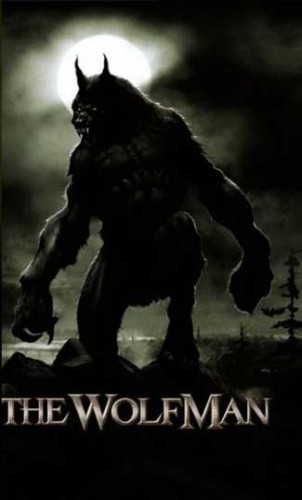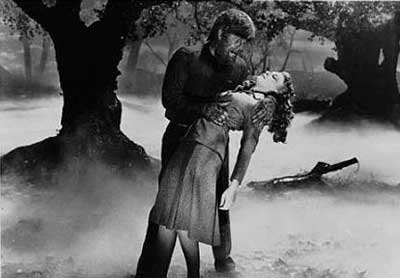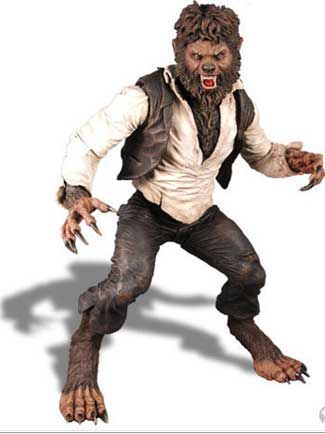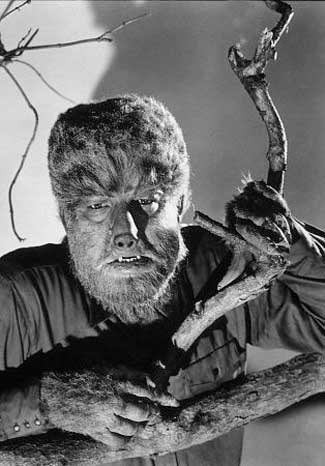Author The Werewolf Book: An Encyclopedia of Shape Shifting Beings
On February 12th, The Wolfman, starring Benicio Del Toro as Lawrence Talbot and Anthony Hopkins as Sir John Talbot will be released after a nearly twoyear wait on the studio shelves.
Those of us who are werewolf fans are eagerly waiting to view the new interpretation of the 1941 classic and to see if hardy and vicious werewolves can compete with the current sex appeal of buff and attractive vampires.
HOLLYWOOD AND THE WEREWOLF
It has often been said that Americans learn their history through motion pictures. For millions of contemporary men and women, the word “werewolf” conjures up images of the actor Lon Chaney Jr. in The Wolf Man (1941), creeping through the nocturnal mists, a good man tortured by the knowledge that the bite of a werewolf has caused him to endure a monthly metamorphosis into a monster during the full moon. Although a wolf, we still recognize Chaney as a man, fully clothed, walking upright in a peculiar loping movement.
In later motion pictures, such as The Howling (1981), An American Werewolf in London (1981), and An American Werewolf in Paris (1997), vastly improved visual effects allow us to witness the complete transformation of man into wolf, but The Wolf Man created a number of werewolf traditions that became cinematic werewolf dogma in many horror films to follow:
*People become werewolves after being bitten or scratched by a werewolf.
*Upon the rising of the first full moon after surviving the attack by the werewolf, the victims are themselves transformed into werewolves. Such shall be their fate forever.
*The process of transformation causes fangs and claws to grow, hair to sprout all over the body, and human compassion to be clouded by blood lust. *Werewolves retain an upright, twolegged human body shape and continue to wear the clothing in which they were attired before the transformation began. Shoes are the only items of wearing apparel discarded before the lycanthropes terrorize the moonlit countryside. The werewolf of ancient tradition runs on all fours and has discarded all vestiges of clothing before the process of transmutation begins. If the shapeshifter should be killed while in the form of a wolf, he or she would return to human shape and be found to be naked.
*Wolfbane is very effective at keeping a werewolf at bay. Garlic is also a good werewolf deterrent, and a pentagram (the fivepointed star) might save your life if it is made of silver.
*An object made of silver is the only thing that can kill a werewolf. (A silver bullet in heart would be added in Frankenstein Meets the Wolf Man, 1943.)
With these cinematic rules for lycanthropic behavior, manners, and mores firmly established in The Wolf Man, Universal Pictures rewrote centuries of werewolf lore and legend. Even the famous folk wisdom “Even the man who is pure at heart/And says his prayers at night/May become a wolf when the wolfbane blooms/And the moon is clear and bright,” was composed by the screenwriter for the film.
WEREWOLVES AND VAMPIRES
It was not as easy detecting werewolves among the human population as it was to hunt down the vampires lurking in the shadows. Perhaps the most essential difference between the two creatures of the Darkside is the fact that the werewolf is not a member of the undead. When werewolves were not in the throes of transformation precipitated by the rays of the full moon or the wearing of the magic wolf belt, they walked about the bustling streets of the city or the pleasant country lanes appearing as any normal human. Werewolves have no need to scamper off to a coffin before the rays of the rising sun begin to burn welts into their hide. Werewolves can freely walk in sunlight.
Mirrors offer no problem for werewolves. They can straighten their collar or comb their hair without worrying if they are casting a reflection. Crucifixes are of no concern. Werewolves might even wear the sign of the cross themselves, attend church services, and perhaps even serve as members of the clergy.
WOLVES AND HUMANS
More than 140,000 years ago wolves and humans formed a common bond and evolved together in one of the most successful partnerships ever fashioned. The wolf’s strength, stamina, keen sense of hearing, and extraordinary sense of smell helped humans to hunt prey and to overcome predators. Because we humans teamed up with wolves, we became better hunters and thus supplanted our rival species of Homo erectus and Neanderthal.
The human species greatly depended upon wolves for its continued existence and modeled much of their behavior, especially in the area of survival skills, upon the wolf. As these prehistoric “wolf men” learned over time to hunt in packs and, with the assistance of their wolf allies, to subdue much larger predators, then certain elements of lupine savagery may well have been “inherited” along with the more noble aspects of a sense of community and mutual support.
From the earliest stages of social evolution when all men and women strove to be like wolves, the human community eventually reached the time when it would be considered improper, antisocial, and criminal to behave like a wolf. Still, there remained the sorcerers and those on the fringes of society who believed that one could attain great power by maintaining those lupine links to a more savage past. They believed that they had the ability to shape shift to werewolveswolf men and women.
HOW TO BECOME A WEREWOLF
According to the ancients, it was believed any skilled sorcerer who so chose could become a werewolf. Throughout history, selfprofessed werewolves have mentioned a “magic girdle,” which they wear about their middles, or a “magic salve” which they apply liberally to their naked bodies. Others tell of inhaling or imbibing certain potions.
Magical texts advise those who wish to become a werewolf to disrobe, rub a magical ointment freely over their flesh, place a girdle made of human or wolf skin around their waist, then cover their entire body with the pelt of a wolf. To accelerate the process, they should drink beer mixed with blood and chant a particular magical formula.
Some werewolves claimed to have achieved their shapeshifting ability by having drunk water from the paw print of a wolf. Once this had been accomplished, they ate the brains of a wolf and slept in its lair. One ancient text prescribes a ritual for the magician who is eager to become a shapeshifter. He is told to wait until the night of a full moon, then enter the forest at midnight. Then, according to the instructions:
Draw two concentric circles on the ground, one six feet in diameter, the other fourteen feet in diameter. Build a fire in the center of the inner circle and place a tripod over the flames. Suspend from the tripod an iron pot full of water. Bring the water to a full boil and throw into the pot a handful each of aloe, hemlock, poppy seed, and nightshade. As the ingredients are being stirred in the iron pot, call aloud to the spirits of the restless dead, the spirits of the foul darkness, the spirits of the hateful, and the spirits of werewolves and satyrs.
Once the summons for the various spirits of darkness have been shouted into the night, the person who aspires to become a werewolf should strip off all of his clothing and smear his body with the fat of a freshly killed animal that has been mixed with anise, camphor, and opium. The next step is to take the wolfskin that he has brought with him, wrap it around his middle like a loincloth, then kneel down at the boundaries of the large circle and remain in that position until the fire dies out. When this happens, the power that the disciple of darkness has summoned should make its presence known to him. If the magician has done everything correctly, the dark force will announce its presence by loud shrieks and groans.
Later, if the wouldbe werewolf has not been terrified and frightened away by the Dark One’s awful screams, it will materialize in any one of a number forms, most likely that of a horrible half human, half beast monster. Once it has manifested in whatever form it desires, the Dark One force will conduct its transaction with the magician and allow him henceforth to assume the shape of a wolf whenever he wears his wolfskin loincloth.
In the classic accounts, once the transformation into wolf has occurred, it is difficult to detect any differences between the werewolf and a true wolf without careful examination. The werewolf that has undergone a complete shapeshifting process is somewhat larger than a true wolf, very often has a silvery sheen to its fur, and always has red, glowing eyes.
Those who became werewolves of their own choice and who sought the power of transmutation through incantations, potions, or spells, gloried in their strength and in their ability to strike fear into the hearts of all who hear their piercing howling on the nights of the full moon.
According to ancient tradition, by far the most familiar involuntary manners in which one becomes a werewolf is to be cursed for your sins by a priest or someone you have wronged or by being the victim of a sorcerer’s incantations.
Another involuntary means of becoming a werewolf, according to some old traditions, is to be born on Christmas Eve. The very process of one’s birth on that sacred night, so say certain ecclesiastical scholars, is an act of blasphemy since it detracts from the full attention to be given to the nativity of Jesus. Thus, those born on that night are condemned to be werewolves unless they prove themselves to be pious beyond reproach in all thoughts, words, and deeds throughout their lifetimes.
When those individuals who became werewolves against their will are not under the power of the curse that forces them to become ravenous beasts, they experience all the normal human emotions of shame and disgust for the deeds that they must commit under the blood spell. They may long for death and seek ways to destroy themselves before they take the lives of more innocent victims.
WEREWOLVES IN HISTORY
Apparently, this technique must have worked very well for some individuals.
In 400 BCE Damarchus, a werewolf from the Greek city state of Arcadia, is said to have won boxing medals at the Olympics.
In about 85 BCE The great Roman poet Virgil speaks of the powers of the werewolf Moeris, from whom he claims to have learned many secrets of magic, including the raising of the dead.
In 175 Pausanias, a Greek traveler, geographer, and author visited Arcadia and met the Lycanian werewolves.
In his City of God (circa 410) the great Roman Catholic clergyman St. Augustine relates the account of certain sorceresses in the Alps who give their unsuspecting victims a special kind of cheese that transforms them into beasts of burden.
In 435 St. Patrick arrives in Ireland and discovers that among his flock are many families of werewolves.
THE WEREWOLF AND THE FULL MOON
Since the very earliest accounts of werewolves, those who would seek to explain the onset of such frightening behavior have stated with authority that it is the light of the full moon that serves as the catalyst for the transformation of human into wolf. The ancient Greeks and Romans associated the moon with the underworld and those human and inhuman entities who used the night to work their dark magic.
Witches, werewolves, and other shapeshifters received great power from the moonand just as the moon changed its shape throughout the month, so could these servants of the underworld transform their shapes into bats, wolves, dogs, rats or any creature they so chose. In addition, they could also change their hapless victims into animals.

THE CHURCH’S WAR ON WEREWOLVES
By 906, werewolves were becoming too numerous and Abbot Regino of Prum condemned as heretical any belief in witchcraft and or in the power of sorcerers to change people into animals. If anyone believed they had the ability to transform human into a creature of another species, they were being deceived by Satan. In 1233, the Church instituted the Inquisition.
In 1407, dozens of Werewolves were tortured and burned during witchcraft trials at Basel.
In 1521 Three werewolves of Poligny, accused of having eaten children and consorted with wild shewolves, confessed to having achieved their transformation from a magic salve. They were burnt at the stake.
1n 1555, Olaus Magnus recorded his observation that the werewolves of Livonia put on a girdle of wolf skin, drink a cup of beer, and uttered certain magic words to accomplish their transformation from humans to wolves.
The infamous Gilles Garnier was burned as a werewolf in 1573, and the notorious Peter Stubbe was executed as a werewolf in Cologne in 1589.
Roulet, The Werewolf of Chalons, a tailor accused of eating children in his shop, is executed in Paris in 1598, and in that same year, the Gandillon family is burned as werewolves in Jura.
DETECTING A WEREWOLF
Werewolves most often attack their victims for the sheer joy of the slaughter, the ripping and biting at the flesh, tearing at the jugular vein with claws or fangs. Its strength is superhuman.
Since there is no time when a werewolf is really vulnerable in its animal form, over the centuries werewolf hunters learned to wait until the creature has shifted back to its human shape.
The werewolf hunters did have some clues when it came to detecting the werewolves among them. As early as the seventh century, Paulos Agina, a physician who lived in Alexandria, described the symptoms of werewolfism for his fellow doctors:
*Pale skin.
*Weak vision.
*An absence of tears or saliva, making the eyes and tongue very dry.
*Excessive thirst.
*Ulcers and abrasions on the arms and legs that do not heal, caused by walking on all fours.
*An obsession with wandering in cemeteries at night.
*Howling until dawn.
Other traditions insisted that the hands may provide the biggest giveaway. Check the palms of a suspected werewolf, and if his palms are covered with a coarse, stiff growth of hair, you had better avoid his company on the nights of the full moon.
Another certain sign of the werewolf, according to a vast number of ancient traditions, lies in the extreme length of the index finger. If you should notice a man or woman with an index finger considerably longer than the middle finger, you have quite likely spotted a werewolf.
Then there is the matter of the eyebrows growing together. If they should meet in the center of the forehead, there is cause for genuine concern that you have encountered a werewolf.
A good many traditions regard the pentagram, the fivepointed star, as a symbol of witchcraft and werewolves. Some werewolf hunters of old believed that the sign of the pentagram would be found somewhere on a shape shifter’s body, most often on the chest or the hand. It was also an aspect of that belief structure that the shadow of the pentagram would manifest on the palm or forehead of the werewolf’s next victim and would be visible only to the monster’s eyes.
And while the eyes of the werewolf appear normal at all other times, when the curse is upon them, their eyes glow in the dark, most often with a reddish hue.
SCIENCE STUDIES WEREWOLVES
Contemporary medical professionals have sought to offer rational explanations for the werewolves that have scourged the past and haunted the present. The term “lycanthropy”(from the Greek, literally, wolfman) was used by Reginald Scot in his The Discovery of Witchcraft to denote an extreme form of violent insanity in which the individual may imitate the behavior of a wild beast, especially a wolf. Scot argued against the Church and the Inquisition and its institutionalized program of torturing and burning of witches, werewolves, and other shapeshifters; and he nearly ended up bound to a stake for his heretical efforts on behalf of reason.
The term lycanthropy was also applied to those individuals afflicted with a form of dark melancholy, a deep depression that gave rise to a violent form of insanity. In his Anatomy of Melancholy (1621), Robert Burton writes that those men and women who are suffering from an advanced form of melancholy that graduates into werewolfism lie hidden throughout the daylight hours, then “go abroad in the night, barking, howling, at graves… they have unusually hollow eyes, scabbed legs and thighs, very dry and pale.”
Dr. Mary Matossian, professor of history at the University of Maryland, viewed such statistics as those from France which proclaimed that 30,000 individuals were condemned as werewolves between the years of 1520 to 1630 and derived a theory that the peasants were eating a rye bread that was contaminated by a fungus that acted as a powerful hallucinogenic. In essence, Dr. Matossian suggested that thousands of men and women were suffering from “bad trips” from a potent fungus that caused them to have delusions that they were magical beings capable of transforming themselves into werewolves.
In the Canadian Psychiatric Association Journal in 1975, psychiatrists Frida Surawicz and Richard Banta of Lexington, Kentucky, published their paper, “Lycanthropy Revisited” in which they presented two case studies of contemporary werewolves.
Their first case, that of Mr. H., obliquely supported Dr. Mary Matossian’s hallucinogenic hypothesis in that he had ingested LSD before he saw himself changing into a werewolf. He saw fur growing over his hands and face, and he craved flesh and blood. Even after the effects of the drug had supposedly worn off, Mr. H. still believed himself to be a werewolf. He was treated as a paranoid schizophrenic, treated with antipsychotic medication, and after about five weeks, released from a psychiatric unit.
Surawicz and Banta’s second case study was that of a thirtysevenyearold farmer, who, after his discharge from the Navy, began allowing his hair to grow long and began sleeping in cemeteries and howling at the moon. Although there was no indication of drug abuse or misuse in Mr. W.’s case, he was freed from his delusion after treatment with antipsychotic medication.
Psychiatrist Harvey Rosenstock and psychologist Kenneth Vincent discussed their case history of a fortynineyearold woman who underwent the metamorphosis into a werewolf in their paper, “A Case of Lycanthropy,” published in the American Journal of Psychiatry in 1977. Although she finally was admitted to a locked psychiatric unit and received daily psychotherapy and antipsychotic drugs, she still beheld herself as a wolf woman with claws, teeth, and fangs and believed that her werewolf spirit would roam the earth long after her physical death. Medical personnel would manage to get the woman under control until the next full moon. At that time, she would snarl, howl, and resume her wolflike behavior. She was eventually discharged and provided with antipsychotic medication, but she promised to haunt the graveyards until she found the tall, dark, hairy creature of her dreams.
In his Bizarre Diseases of the Mind, Dr. Richard Noll lists the traditional traits of the lycanthrope:
*The belief that they are wolves or wild dogs.
* The belief that they have been physically transformed into animals with fur and claws.
*Animallike behavior, including growling, howling, clawing, pawing, crawling on all fours.
*The desire to assault or kill others.
* Hypersexuality, including the desire to have sex with animals.
*Use of a hallucinogenic substance to achieve the metamorphosis of human into a wolf.
*A desire for isolation from human society (stalking the woods, haunting cemeteries).
*The belief that “the devil” has possessed them and provided the power that causes the transformation from human to wolf.
THE SHARED SEED OF THE WEREWOLF
While most of us have become “domesticated” and listen to the inner voice of conscience that has been strengthened by moral and spiritual values and cultivated over centuries of civilized behavior, those individuals who have succumbed to the more vicious seed of the wolf within them walk among us today as those sadistic sex criminals who slash, tear, rip, rape, mutilate, and cannibalize their victims. When one compares the details of the offenses charged to alleged werewolves during the witchcraft mania of the Middle Ages with the offenses attributed to such sex criminals as the Chicago Rippers, Harry Gordon, Richard Ramirez, Henry Lee Lucas, and Jeffrey Dahmer, it becomes clear that there exists a true werewolf psychosis that can cause people to believe that they are transformed into wolves or can cause them to commit cruel and vicious crimes as if they were wolves scratching, biting, and killing their prey.
While the werewolf as sex criminal constitutes a very grim reality and a serious physical threat to unsuspecting members of society who are its potential victims, the werewolf as a creature of superstition poses a psychic threat to those who may trespass beyond the boundaries of logic and reason into the dangerous and uncharted regions of the supernatural. The werewolf of tradition is the deliberate creation of a human who, motivated by a desire for power or revenge, has sought to release the beast within and accomplish the transformation of human into wolf.
Since prehistoric times the bloodline of the wolf has blended with that of our own species, and each one of us bears the personal responsibility of honoring the noble aspects of our lupine heritage and, at the same time, keeping the savage bloodlust under control.
 Horror News | HNN Official Site | Horror Movies,Trailers, Reviews
Horror News | HNN Official Site | Horror Movies,Trailers, Reviews










